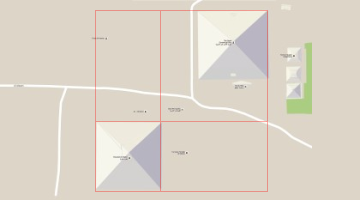 Overview: Analysis of the site of the Great Pyramid of Giza reveals that the positions and relative sizes of the pyramids may be based on the golden ratio.
Overview: Analysis of the site of the Great Pyramid of Giza reveals that the positions and relative sizes of the pyramids may be based on the golden ratio.
Evidence of the Golden Ratio in the Great Pyramid complex.
There are many pyramid theories and questions as to who built the pyramids in ancient Egypt. It’s commonly known though in Egyptology that the proportions of the Great Pyramid of Egypt are within inches of a golden ratio-based pyramid. This is discussed in detail in my article Phi, Pi and the Great Pyramid.
Some say, however, that this single piece of evidence is just a simple coincidence. The primary rationale given to deny this claim is that there is no written historical evidence that the ancient Egyptians had any knowledge of the golden ratio.
That’s a reasonable objection, but what if the evidence showed that the application of the golden ratio at Giza was not limited to the Great Pyramid? That evidence is presented in this article.
The golden ratio connection to the Great Pyramid of Khufu
Let’s quickly review of the evidence on this wonder of ancient architecture. A golden ratio pyramid is based on a triangle whose three sides represent the mathematical relationship that defines the golden ratio. This triangle, known as a Kepler triangle, has base of length 1 and a hypotenuse whose length is Phi. The height of this right triangle is the square root of Phi. Using the Pythagorean theorem, (a²+b²=c²), this triangle represents one of the golden ratio’s unique properties:
1 + Phi = Phi ²
The geometry of the Great Pyramid of Giza varies by less than 0.025% from that of a perfect golden triangle pyramid. This is a difference of just inches in its height of 480.6′. Could the pyramid be this close to the golden ratio in its design, but with no intent of this by its builders? That seems rather amazing, if not unlikely. If the builders thought the golden ratio was important enough to use for this critical measure, would they use it only in this one instance?
What if the golden ratio appears in other aspects in the pyramid complex?
I began to investigate this question after receiving a comment from Pat Miller, a visitor to this site. Pat observed,
The first time I saw the 6 smaller pyramids of Giza, the image of the scale rulers placed next to artifacts came to mind. Three points denote a circle, so 9 points could denote 3 circles. Has anyone, or could someone, calculate their sizes and spacial relationships?”
I have yet to find a relationship based on those circles. The question though inspired me to look at the relationships of the pyramids and the topography of the site.
The Golden Ratio in the three small pyramids with the Tomb of Queen Hetepheres
I used PhiMatrix, with its pixel-level accuracy, to see what ratios appeared in the site’s topography. Every line in the PhiMatrix grid is in a golden ratio proportion to the ones on either side of it.
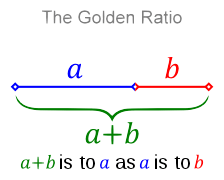
I first placed the PhiMatrix grid over the “scale rulers,” the three small pyramids next to the Great Pyramid. Here I found a golden ratio in the placement and dimension of the middle pyramid in relation to the perimeters of the two outside pyramids:
The Pyramids of Queens reveals yet another Golden Ratio
There are three other small pyramids, which include the Pyramids of Queens. These are next to the Pyramid of Menakaure, the smallest of the three large pyramids. I measured these next. Although irregularly shaped, the distance between the corner points of their bases revealed the very same golden ratio relationship that appeared in the three small pyramids next to Khufu’s pyramid. Click for larger image:
The Golden Ratio in the pyramids of Khufu and Khafre
I then used PhiMatrix to investigate the relative positions of the two largest pyramids of the complex. Here I found yet another very surprising relationship. Create a rectangle with a perimeter that outlines the bases of the two larger pyramids, and the relationships are found:
- The base of the middle pyramid is a golden ratio of the width of that perimeter rectangle.
- The base of the middle pyramid in relation to the height of this perimeter rectangle is also very close to the golden ratio. It measures at 1.608, a variance of only 0.06%.
- Taken together, this results in a simple, yet elegant, golden ratio geometry. This geometry defines a relationship between the pyramids of Khufu and Khafre.
Click on images below for the high resolution images:
The Golden Ratio in the pyramids of Khafre and Menkaure
I next investigated the topography of the smaller pyramid in relation to the middle pyramid. Here too, I found a relationship. Create another rectangle with a perimeter that outlines the bases of the middle and smaller pyramids. The base of the smaller pyramid is Phi² (a golden ratio of a golden ratio) of the width of that perimeter rectangle.
The red line closest to the center represents the primary golden ratio of the width of the perimeter rectangle. The red line bordering the right side of the small pyramid is the golden ratio of that primary golden ratio.
Analysis of the Giza site plan by others
After first publishing this article, John Gury alerted me to some similar analysis of the Giza complex site. One of the plans expressed a concept similar to the Khufu-Khafre relationship I show above. This was by Jiri Mruzek from his site at http://www.vejprty.com/gizaplan.htm. Note that design is based on a square. The center of the square defines the middle pyramid. Each arm of the cross is a golden rectangle:
The apex points of the Khafre and Menkaure pyramids define the corners a Golden Rectangle!
Another site layout, proposed by Chris Tedder, provided a far simpler and more elegant approach yet. It’s based on two golden rectangles (one in portrait orientation, one in landscape orientation) whose corners align with the apex of each pyramid. I’ve included the original illustration below on the left. I then recreated it with the highest resolution Giza site map that fit on a 1920×1080 screen, and rotated it 90 degrees. The overlay of the PhiMatrix grid reveals how simple and precise this relationship is. I also applied this approach to a satellite image from Google Maps. I used PhiMatrix to create a crosshair (in green) on each pyramid to eliminate the perspective distortion and show the true position of its apex. I set the grid transparency low so as to not obscure the actual lines of the pyramid bases. The bases of the pyramids are not as affected by perspective distortion as are their apex points. Click on the images for full resolution.
I then combined the concepts of both Mruzek and Tedder to create this view of the site plan. The interesting addition is that the apex of Menakaure (the small pyrmid) is fairly closely aligned to the third golden ratio line of the square, as indicated by φ³. Click HERE on on image below for full resolution:
Validation of the results based on surveys of the Giza site
Seeking to validate these results with other measurement, my investigation took me to an analysis by Glen Dash based on very precise site surveys of the Giza site. Glen combined the results of Flinders Petrie, who surveyed the Pyramids in 1880 and 1881, and those of David Goodman and Mark Lehner, resurveyed the Giza Plateau in 1984 and 1985. Glen’s analysis provides the locations of the apex and base of each of the three pyramids to within ±10 centimeters, or about 4 inches. I used these measures to calculate the ratios presented above. Click on images below for full resolution:
- Giza site survey by Glen Dash
- Giza Pyrmid ratios by Gary Meisner
This analysis shows a very close alignment of the pyramids to these golden ratios:
- The golden rectangle formed by the apex points of Khafre and Menakure has sides with a ratio of 1.613.
- The golden rectangle formed by the apex points of Khufu and Menakure has sides with a ratio of 1.618.
- The ratio of the base of Khufu to that of Khafre averages to a ratio of 1.610.
A progression of Golden Ratios
The analysis shows that the Giza site thus shows the applications of several basic golden ratio concepts:
- The bases of Khufu and Khafre express the concept of dividing a line at its golden ratio point.
- The apexes of Khafre and Menakure express the concept of the golden rectangle.
- The pyramid triangle of Khufu expresses the concept of the golden rectangle, aka the Kepler triangle.
Golden ratios beget golden ratios
One of the unique properties of the golden ratio is that when you DO use it in design, it creates multiple golden ratio relationships. This is illustrated by the expanded PhiMatrix grid below. Each line is in golden ratio proportion to the ones on either side of it, so imagine how many golden ratios there are to be found. It should be no surprise that the Giza site, if in fact based on the golden ratio, would produce multiple site layout variations that all contain golden ratios.
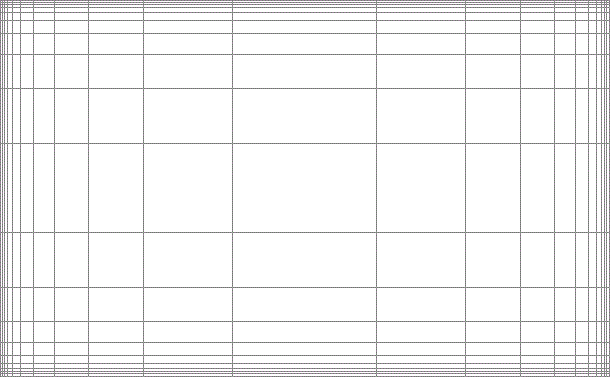
Multiple golden ratios in the design of the Great Pyramid complex
Could these golden ratio relationships be the basis for the sizes and positions of the pyramids at Giza? The ancient Egyptians did not reveal that to us in the writings they left behind. Perhaps, however, the evidence is beginning to speak for itself.
This analysis now provides us with at least eight instances of golden ratio proportions in the topography of the Giza site. This is in addition to the geometry of the Great Pyramid itself, which is within 0.25% of the proportions of a perfect golden ratio pyramid. The chance that golden ratios would appear nine or more times in the positions and sizes of these pyramids by coincidence alone seems quite unlikely.
If the SETI program received a message from space of these mathematical relationships, I suspect they’d be proclaiming the discovery of extra-terrestrial intelligence. When found in the site plan of Giza, should we chalk it up to chance and coincidence, or conclude that its design was based on these mathematical concepts?
This combined look at the evidences for golden ratios in the site plan of the Pyramids of Giza gives far more reason yet to believe that it does in fact exist, and was included in the design plan of the builders.
Which specific site design was used by the Egyptians in reality is anybody’s guess. The fact is that reasonably accurate plans can revealing golden ratios can be developed with reasonably simple approaches. This, in turn, should provide compelling evidence that the original site plans were based on a similar or related methodology.
Golden ratios are a simple and common outcome of many geometric constructions
Appearances of the golden ratio in nature and design should not be a surprise. The ratio appears in a variety of places in nature, and in features of the human face. This can lead to it being perceived as natural or aesthetically pleasing. This in turn can lead to its use in man’s own creative endeavors. It’s also very commonly found in a variety of simple geometric constructions, such as those shown below (AC/AB=1.618):
There is thus no need to assume that any use of the golden ratio requires a knowledge of irrational numbers or advanced mathematics. It’s really quite easy to construct with just a length of rope and a straight edge. It sometimes shows up even when you don’t even plan it.
Methodology of the analysis
The topographies shown above are based on maps of the Great Pyramid Complex site provided by ZeeMaps.com. In my first pass at this analysis, I used satellite images from Google Earth and Google Maps. The same relationships were evident, but there are shadows and parallax distortion in these images. This made it clear that a topographical map of the site would provide more accurate results yet. Click on images for higher resolution.
ZeeMaps uses Google Maps to display its maps. My analysis of course assumes that the topography provided in these maps is accurate. If so, this provides compelling evidence that the ancient Egyptians may have used the golden ratio in their construction of the pyramids at Giza. This could have been with intent. It also could have resulted from the use of some simple geometries in laying out the site.
One thing that seems certain: With all the technology, precision and resources that went into the construction of these pyramids, the builders must have had something very specific in mind in determining their sizes, positions and geometries. The sides of the square base of the Great Pyramid align to within 0.7 degrees of the four compass points based on true north. Its base was squared to within 0.2 degrees. It’s unreasonable to assume that the relative sizes and positions of the three large pyramids and six small pyramids were just an afterthought left to chance.
Other nearby ratios do not fit the topographical evidence as well
To minimize any doubt that the proportions found in the topography represent ratios other than the golden ratio, consider the images below. The grid lines on these images show the positions of the base of the pyramids if ratios of 1.600 and 1.625 had been used rather than 1.618. The alignment of the pyramids is clearly closer to the golden ratio. Click on images for higher resolution.
- Khufu Khafre at 1.600
- Khufu Khafre at 1.625
- Khafre Menakaure at 1.625
- Khufu Khafre at 1.625
Other theories on the placement of the pyramids – The Orion Connection
It has been proposed by Graham Hancock and Robert Bauval that the positions of the three large pyramids correspond to the positions of the three stars in the belt of the constellation Orion. This is a rather brilliant observation, and is supported by the alignment of the air shaft of the Great Pyramid to the belt of the constellation Orion, as it appeared around 2500 BC. I tested this alignment of the stars by overlaying an image of the constellation to a topography of the pyramid complex. Click on the images for higher resolution.
- Orion’s belt
- Constellation of Orion
- Orion’s belt over the three pyramids at Giza
The relative distances between the pyramids matched quite perfectly to that of the stars. The angle of the lines formed by their positions was slightly off by my analysis. I aligned two stars of the belt to the two smaller pyramids. When this was done, the third star was positioned slightly to the left of the apex of the large pyramid. By my measurement, the angle formed by the three stars is about 172.6°, while that of the three pyramids is about 175.2°. The alignment of the apex of each pyramids to the stars is thus very close, but could have been even closer yet if this were the intention of the builders.
The relative brightness of the stars in Orion do not correlate to the relative sizes of the pyramids
I also noted that while the stars are of roughly equal brightness in the sky, the relative sizes of the pyramids are very different. The center star in the belt is the dimmest of the three, but the southernmost pyramid is by far the smallest of the three. If the pyramids were meant to be a terrestrial representation of the night sky, what was the basis for their very different sizes?
The Orion Connection explains the positions of the pyramids, but not their sizes
Even if the connection to Orion is true (Hancock and Bauval offer a compelling body of other evidence that it is), this defines the only the position of the apex of each pyramid. It does not explain their relative sizes. Could the golden ratio be the key factor yet that led the builders to the positions and dimensions of the pyramids? Based on my measurements of the pyramids presented above, the application of the golden ratio to the topography of the site provides a even higher degree of accuracy than the stars of Orion’s belt. It appears to better explain both the placement and the dimensions of the pyramids.
The Great Sphinx
There’s one more monument at the Giza site that I’d be remiss to exclude from this analysis: The Great Sphinx. The satellite and aerial images of the Sphinx on Google Maps and Google Earth are too blurry to use with any reliability. Look, however, at the topographical map of the Sphinx on ZeeMaps. I think you’ll be find the images rather interesting as well. Click on any of them for higher resolution.
- Great Sphinx: Google Maps Satellite Image
- Great Sphinx: ZeeMaps Topographical Map
- Great Sphinx: Second golden ratio from first
One more step towards a deeper understanding of a great mystery
I find these results intriguing and compelling. There are admittedly many questions that remain. If the golden ratio were applied to the pyramids with intent, there are many alternative approaches to their design that could have been included in the site plan and the sizes and proportions of the pyramids. Still, it seems that the relationships shown are fundamental enough to not be deemed arbitary. They are also quite precise in describing the dimensions and proportions that exist. This should make them unlikely to be the result of coincidence or chance.
I hope these discoveries and analyses provides others with an insight to build upon in doing more research yet. There is still much to understand about the history, mathematics, design and purpose of the building of the pyramids. I hope too that those with access to the site of the Great Pyramid complex will take more accurate measures yet to confirm or deny the proportions that the maps appear to reveal.
You, as visitors to this site, are my peer review group. You can use PhiMatrix for free to examine this evidence for yourself. For those of you who use Autocad, there are site details available on the Internet that can be used for more detailed analysis yet. I invite your analysis and comments.
Gary Meisner
www.goldennumber.net
References:
ZeeMaps.com maps of the Great Pyramid of Giza Complex, with editable version.
Google Maps Satellite imagery of the Great Pyramid of Giza Complex
PhiMatrix Design and Analysis Software
Graham Hancock and Robert Bauval on the Great Pyramid and the Orion Connection
Giza Site Plan analysis by Jiri Mruzek
Giza Site Plan analysis by Glen Dash
Wikipedia on the Great Pyramid of Giza
Wikipedia on the Pyramid of Khafre

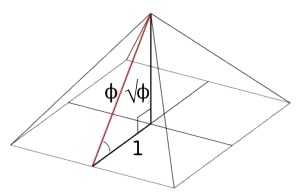
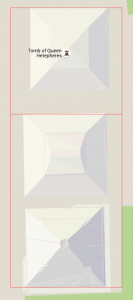
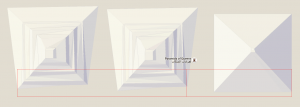
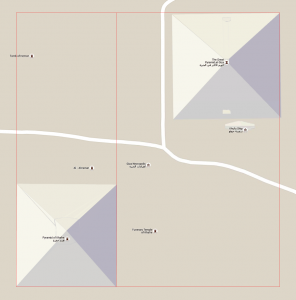
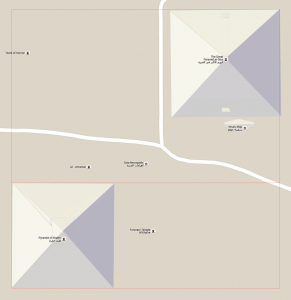
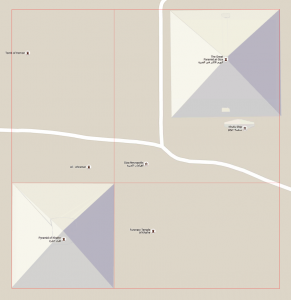
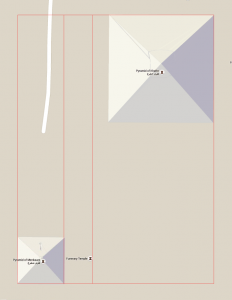
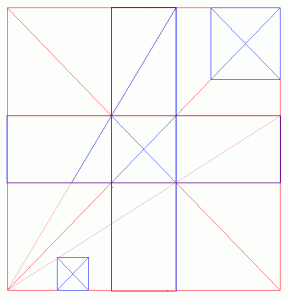
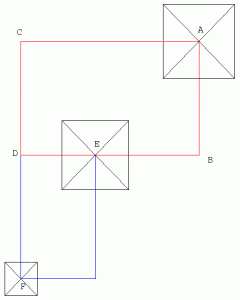
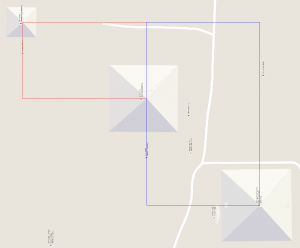
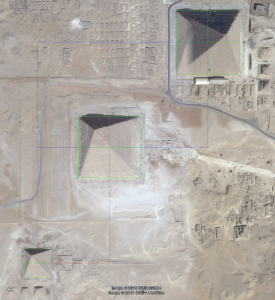
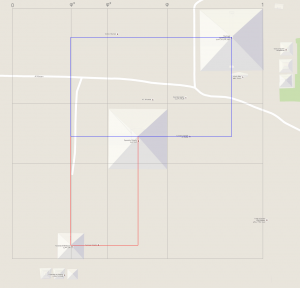
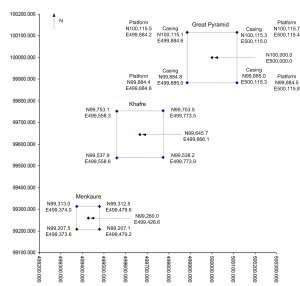
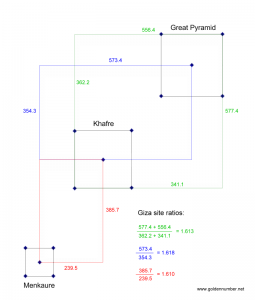
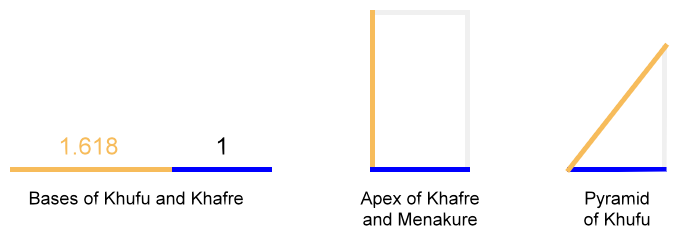
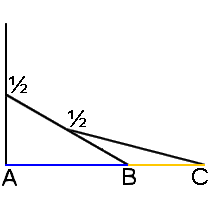
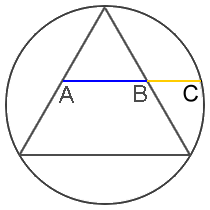
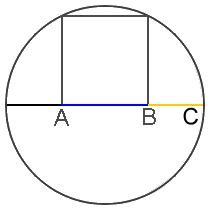
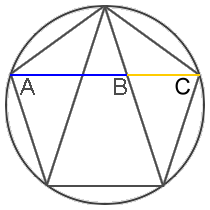


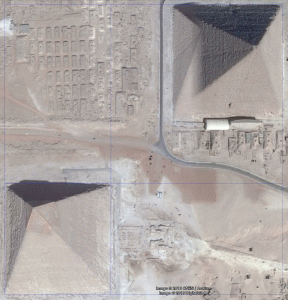
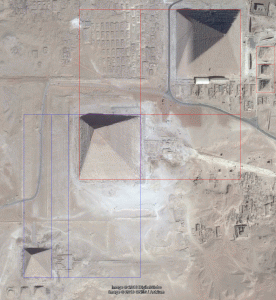
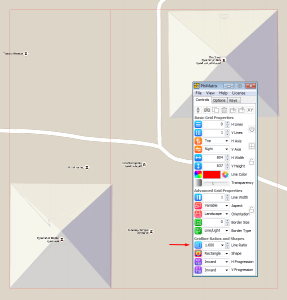
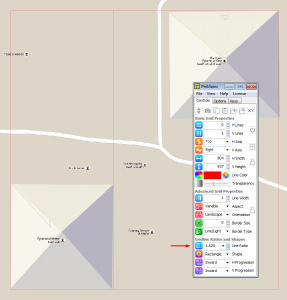
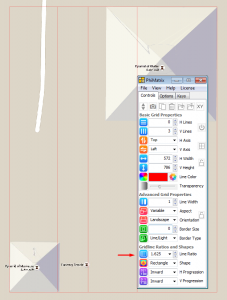
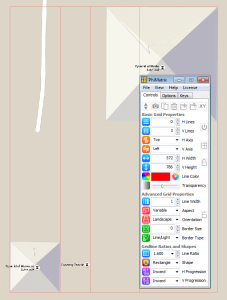


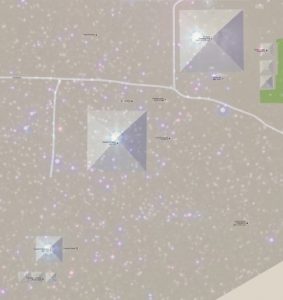
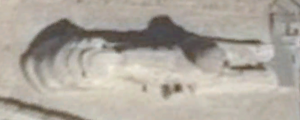




One of the most analysed ground plans there is.
http://www.vejprty.com/gizaplan.htm
Thank you, John, for the great link. I was unaware of this work. Portions of it duplicate and corroborate some of the findings I present above. Another portion adds a wonderful new insight that I didn’t see. I’ve added an addendum to reference this work and included some key illustrations.
Great work!
I can contribute some aspects on the golden mean. I pointed this out on my articles about japanese gardens in particular about the stone setting in Ryoan-ji dry stone garden in Kyoto. Here several stone groups line up in 7-5-3 relationships with inherent golden mean relationships. To be found under Jochen Wiede, Japanische Gartenkunst or in my resent book: Fernöstliche Gartenkunst – Geheimnisvolle Gärten Chinas und Japans. (Marix Verlag 2018)
From the above link:
“1) Draw horizontal and vertical lines (axes) from the pyramid centers.
2) Draw an exact golden diagonal from the intersection of ‘d’ and ‘e’.
(Any rectangle with this diagonal is a true golden rectangle.)
3) Draw lines ‘h’ and ‘g’ from the intersection of ‘c’ and ‘f’.
Now, the rectangle formed by lines a-b-c-h is an extraordinarily accurate golden rectangle:
Instead of 74 inches, the “inaccuracy” of its long side now stands at 0.18 inches over the distance of 17,833.8 inches ..
The ratio of sides in this golden rectangle is 1.618021, which is just 0.00001 off the true value of Phi.
The line ‘g’ is an extraordinarily accurate golden diagonal:
Instead of the correct 31.71747.. degrees, its angle is 31.71767.. mere 2/10,000 (half a second) degree off.”
You need to read Mario Livio’s book The Golden Ratio. He has a specific section about the Pyramids and he says that they do not use the Golden Ratio. While you talk about topography, he talks about the actual building. It is very interesting.
Hello Desiree,
I always appreciate recommendation on new information on the golden ratio. If you spend a bit more time on my site though you’ll find that I cover the possible appearance of the golden ratio in the Great Pyramid itself in my article here:
https://www.goldennumber.net/phi-pi-great-pyramid-egypt/
So yes, I’m very familiar with Dr. Livio’s work and with the discussions and debates on whether the golden ratio appears in the Great Pyramid, the Parthenon, the UN Secretariat Building and many other topics. One thing you see as you delve deeper into the golden ratio is that there is a lot of misinformation and disagreement over where it appears. Academics tend to take a very narrow, theoretical viewpoint and deny its appearance outside of mathematics where it can be proved. Uninformed enthusiasts tend to say it exists in many places where it does not. I have several articles which make this point, and which may be of interest:
https://www.goldennumber.net/golden-ratio-myth/
https://www.goldennumber.net/golden-ratio-misconceptions-by-george-markowsky-reviewed/
https://www.goldennumber.net/fast-company-design-john-brownlee-golden-ratio/
https://www.goldennumber.net/golden-ratio-design-beauty-face-evidence-facts/
https://www.goldennumber.net/facial-beauty-new-golden-ratio/
A good portion of the content in these articles shows the misrepresentations and errors in statements made by leading Ph.D.’s in mathematics. Surprising, isn’t it.
Dr. Livio’s book is generally very good, but it too contains bias and errors. On the pyramid, yes there’s debate and it’s difficult to prove, but even Dr. Livio on page 56 of his book states “We therefore find that s/a = 612.01/377.90 = 1.62, which is indeed extremely close to (differing by less than 0.1 percent from) the Golden Ratio.” Add to that some very interesting dimensions in the site topography that are as close to the golden ratio as well and I think you may have to admit that it’s just as difficult to disprove its use as it is to prove it. Conclusions on many topics in life are based more on what we want to believe that hard facts that are completely undeniable.
Dr. Livio also wrote on page 166, “Before we discuss artists who did use the Golden Ratio, however, another myth still needs to be dispelled. In spite of many existing claims to the contrary, the French pointillist Georges Seurat (1859-1891) probably did not use the Golden Ratio in his paintings.”
I invite you to read my counter to Dr. Livio’s statements on these pages:
https://www.goldennumber.net/georges-seurat-golden-ratio-in-art/
https://www.goldennumber.net/georges-seurat-golden-ratio-in-art/2/
https://www.goldennumber.net/georges-seurat-golden-ratio-in-art/3/
In addition to many rather clear uses of the golden ratio within his paintings, Seurat painted at least two dozen of his hundred plus paintings on wood panels cut to golden rectangle proportions.
Keep reading, and don’t believe everything you read. Get both sides, do your own analysis and come to your own conclusions.
Great job!
I have an idea:
Based on the positions of the pyramids, compared to the Orion belt, they look slightly off – true, but – positions of stars change in time, check this:
https://www.wired.com/2015/03/gifs-show-constellations-transforming-150000-years/
Can We try to find the time, when stars were exactly matching the positions of pyramids and that would be the time, when they were built. Right? I am sure much earlier then 4000 years ago.
I don’t know why peeps be harping on only the 3 Giza pyramids as aligning to stars ( namely Orion’s Belt ) because ALL pyramids in Egypt align to stars, for example, Andromeda and the rest of Orion. Scour Wayne Herschel’s work at The Hidden Records. It’s all there.
It is very interesting to see that In normal people’s eyes, they are just a lot of pyramids sitting there randomly. But in a mathematicians’ eye, they are aligned in a very specific place with the golden ratio.
Use the quadratic formula to solve x2 – x – 1 = 0 (Kepler’s Triangle rearranged)
You’ll get the roots at 1,618033989 or -0,618033989
x = Phi
The vertex of the associated parabola is at (0.5, -1,25)
The focal length is also 0.25, making the coordinates of the focal point (0.5, -1)
https://imgflip.com/i/1zxrlo https://imgflip.com/i/1zz7rn
One more: https://imgflip.com/i/200t70
– The small pyramids east of Khufu are a 2×182 days calendar of Khufu!
– There are twice one week between the two ends of the calendar After these weeks the
shadow in the morning will goes to the other side of the calendar. There are about 110-
120 meters between them!
– The start is at the line of the pyramid of Khufu, and the other side is in the middle of
the small windows of the church.
You can see them at “Giza timekeeper” on youtube
Andras
An interesting read, which i can add to the other tens of thousands of words I have read on this subject. I might point out two things, the second one first.
Your measurements of the Sphinx are off a bit since ancient “improvements” have been made to the monument with masonry overlays which have changed the overall dimensions, particularly the length of the paws and the size of the rump. For the most part it is impossible to determine the original surface.
Regarding the sizes of the pyramids, the Egyptians were able to precisely measure distances but, other than the base sizes of the pyramids, used other measuring to produce the shape. Quite simply, they used angles to built the structures. The great pyramid of Khufu was built by angling the sides at a ratio of 14 to 11. This produced a height of 280 cubits on a square base of 440 cubits (the royal cubit used was approximately 21.7 inches). Similarly, the pyramid of Khafre was built with a side ratio of 4 to 3 and the pyramid of Menkaure with a ratio of 5 to 4
Whether the Egyptians intended any of these numbers to represent phi or pi is total conjecture at this point. It can be said, however, that they knew the value of pi to be 22/7. Thus, any measurement or ratio that contains a multiple of either 7 or 11 can be seen to be a multiple of pi. The Great Pyramid with its side ratio 14 to 11 can be considered to be (44/pi) to (pi/7).
I might also point out the ambiguity of measuring points you have used on the two sets of smaller pyramids. On the three at the Khufu pyramid you have used the northern base of two compared to the southern base of the third. On the three at the Menkaure pyramid you have used the northeast corners of two compared to the southeast corner of the third. Picking and choosing measurement points is hardly a logical way to support a conjecture.
Thanks for the information on the modern “improvements” to the Sphinx with masonry overlays. I wasn’t aware of that and would like more information if you have it. From what I found in a quick search, it appears that the overlays were just brick-sized stones that created a thin veneer. If so, this wouldn’t have significantly changed the dimensions and proportions on a monument that is 240 feet in length.
Re the ambiguity of the measuring points on the smaller pyramids, the point isn’t really dependent upon which compass point of the base is used. It just says that if you draw a line along the land upon which they were built, they appear to have chosen to anchor the corner of the center pyramid at the golden ratio cut of that line. This could have been done with a very simple geometric construction of the golden ratio, but when combined with other possible appearances of the golden ratio in the pyramids and the site itself would present a better case than just a single instance of the golden ratio.
At this point in time, all the proposed derivations of the pyramid dimensions and positions is conjecture, but I think gathering as much information as we can will hopefully lead to more discussion and discoveries.
It’s a fun game we play, introducing modern ideas and biases to explain the thought processes of builders 4-5000 years ago.
On the Giza plateau there are three large and six small pyramids. Each pyramid has 9 points associated with its location – the four corners, thee mid point of each side and the apex. Due to wear, damage and erosion each of these points can only be surmised, but not precisely determined.
With 81 distinct points laid out on a plane, there are 3321 separate distances that can be measured. Each of these 3321 distances can be compared with any of the others to produce a relative ratio.
I’m pretty sure that with the large number of ratios produced, many will be equal to, or very equal to pi, e, phi, the digits of c, the digits of Avogadro’s number or any other physical, chemical, electrical or astronomical constant you may choose.
Many of these measurments are confusing because we try to relate them to modern feet or inches. The Egyptians used the Royal Cubit which surviving measuring sticks show to be very nearly 21.7 inches. If the distances on the Giza plateau are “converted” back into cubits you’ll find that most are whole numbers, or at least very simple fractions of a cubit.
The Egyptians used whole number ratios to determine the slopes of the pyramids and their relative placement was measured in cubits. They weren’t concerned with pi or phi; we just think they were because many of the ratios of measurements they did use closely approximate those constants. Thus, any ratio using multiples of 7 or 11 can be related to pi; and any ratio using multiples of 5, 8, 13, 21, 34…. can be related to phi.
From Wikipedia: In … historical analysis, PRESENTISM is the anachronistic introduction of present-day … perspectives into … interpretations of the past.
You make some good points. Yes, there is always some guesswork or creative license in any attempt to try to understand the how and why of what has been created by others, whether it’s a pyramid from 4,000 years ago or a painting created by an artist last week. And yes, separation of time, technology and culture makes it even more difficult. I use four “rules of engagement” whenever doing such an analysis that should greatly minimize the issues you’ve presented:
Relevance – Focusing on the most prominent features. Re your 3321 distances, if my analysis were based on connecting the mid point of the northern face of Khufu to the apex of Menkaure in relation to the southwest corner of Khafre to eastern mid point of Khufu, you’d be right in challenging its relevance and validity. That’s not the case though. Most of the measurements presented are based on the most fundamental and obvious points of the pyramids, such as the three apex points of the pyramids and the height and base dimensions of the largest. These measurements are all based on very simple geometries, not a computer analysis of all possible combinations seeking a result close to a desired number.
Accuracy – The results must be so close to the golden ratio that the likelihood that they were the result of another number is minimalized.
Repeatability/Consistency – A conclusion is much stronger if we find multiple relevant, accurate results than just a single one.
Simplicity – The observations that form the basis for the conclusion should be based on the simplest possible measures.
So while all of your 3321 distances are possible measuring points, the above rules eliminate all but the simplest, most relevant ones and the results were highly accurate and were observed a number of times. That’s not a guarantee of the conclusion’s accuracy, but it significantly minimizes any notion that the analysis was just a fun meaningless game of playing with the numbers.
The seked method you mention to determine a slant with integer numbers was in use by the Egyptians, and could very likely have been used in the Giza construction. The interesting question then is why did they pick the one set of numbers – 11 and 14 (or 5.5 and 7) – that produce a geometry that was within fractions of a percent of accuracy to the golden ratio, one of the most intriguing numbers in nature, and pi, one of the most fundamental numbers in geometry. It could all be one very grand coincidence if it just applied to the proportions dimensions of the Great Pyramid itself, but then we find the golden ratio in the most fundamental proportions of the positions of the pyramids too. That would make the odds of it being a coincidence far, far greater yet. And since this is all based on proportion, not absolute numbers, it really makes no difference if you’re using cubits, feet or any other unit of measure.
Of course they knew the golden number and PI and not forget the meter.
3,1416-1,6180= 1m + One Royal cubit 5236 cm. 0,5236 Times 6 = 3,1416 met,That is the cirkumference of a cirkel whit the diameter of exektly 1 meter. But there is so much more they keep hidden from us.
Hi Gary,
What a fantastic website! And I have very much enjoyed the articles on the Pyramids.
I would just like to let you know that I have used some of your images in my own blog, and I hope that’s ok. Here is the link to the post: https://lebalcon2.wixsite.com/website/blog/10-sun-worship-light-and-phi
In particular I found your site plan of Giza amazing.
One thing that struck me with the ‘Giza Pyramid Ratios’ diagram was the value in metres of the Western side of the blue rectangle: 354.3 m, because 354.36708 is the number of days in 12 lunar months. When I noticed that, I had to have a closer look.
I’ve seen the Flinders Petrie figures for the pyramids in feet, but I hadn’t come across the measurements and diagram by Dash, so thanks for sharing that.
I was surprised because the 354.3 m side of one of the squares is really very close to 354.36708, and what’s more it’s in metres. Often, with ancient monuments, the English foot works really well, because it’s a very very old measurement, and there’s a general conception that the metre came in with Napoleon, but of course it is also very old. Did the pyramid builders use metres?
If the Western side of the blue rectangle on your diagram is supposed to encode the number of days in 12 lunar months, then the longer side, the one that runs West to East, is this figure times phi, as you point out. That would make the blue rectangle a sort of lunar – golden rectangle, and so if you take the actual value of 12 lunar months in days as your measurement in metres, 354.35708 (rather than 354.3) and multiply it by 1.6180339887, you get an even better correspondence between both sides, in terms of phi. 354.36708 x 1.61803399= 573.3779799. 354.3 x 1.618 = 573.269442 and the longer side of the blue rectangle is 573.4, so it seems that the lunar figure fits very well.
There’s another solar / lunar figure too, the length of one side of the middle pyramid, 215.3 m, plus the distance to the extended southern side of the Great Pyramid, 131.3m, makes 346.6m. There are 346.62 days in an eclipse year, or draconic year, the time taken for the Sun (as seen from the Earth) to complete one revolution with respect to the same lunar node.
This also means that, looking at your green rectangle, the right side, the one that includes the Eastern side of the Great Pyramid, and measures 577.4m, this line can be divided in 5, and the side of the Great Pyramid is worth very close to 2/5 of this line, as 577.2 x 2 / 5 = 230.88m. And 346.6 / 2 x 3 = 519.9, and this closely matches another measurement: the centre of the Great Pyramid to the Eastern side of the Menkaure pyramid projected upwards, or to put it a bit more simply, the longer side of your blue rectangle, but a bit shorter. 520 / 3 x 2 = 346.667, which is the eclipse year in days. So what’s really interesting about your green rectangle, I think, is that firstly, it’s a lunar golden rectangle, and secondly, it intersects another rectangle which has the value of an eclipse year in days converted to metres for it’s short side, and 556.7 or 556.4 for its longer side, i.e. the top of your green rectangle, and that together, these two rectangles are placed in such a way as to position the three pyramids. Centre to centre, the North-south line between the two bigger pyramids is, in metres, the value in days of 12 lunar months, and southern side to southern side, the North-South line between the two bigger pyramids is the value in days of an eclipse year, converted to metres. Obviously, the link with Orion is famous, but I was surprised to find the importance of these lunar and solar figures here.
Many thanks
Melissa
p.s. You might be interested in my idea of phi days – days when darkness and light are in phi ratio, Certain sacred sites that I have looked at are linked geographically by exactly the same azimuth as the azimuth of the rising sun at the first moment of sunrise on a phi day at one of the two sites, and there is a whole network of phi day sunrise lines across Europe.
see https://lebalcon2.wixsite.com/website/blog/4-the-michael-alignments
You’ve ask several Questions wondering if or why the builders of the Kufu Pyramid could know the Golden Triangle,( means or ratio) was involved in the design. You’ve also mentioned Right at the beginning you use the word “Divine” before “golden triangle”, “beauty” and other nouns. This is you’re answer( I think you know). This ” Pillar) was what the Lord God of the bible built. (Isaiah 19:19). The passages are a walk of the Jews and the Church of Jesus – and His Birth, death and resurrection (between these). There’s even a Rapture Vent above the end of the church dispensation). This is a Chronology of mans walk under God from Exodus to The Kingdom age (post Millennium reign) or the Jewish Diaspora or Hell and the Lake of Fire . The Exterior is and 8 sided Pyramid featuring the calculated design of our earth and distances in our Solar, math symbols, dimensions. This pyramid is the only building with the Biblical “Chief Corner stone” (Jesus) and it’s a 1/10,000ths Prototype of the New Jerusalem missing a base extension to make it Four-square 1500 miles square – due to the Golden mean limitations. I believe it’s called a Pillar in Isaiah 19:19 ( as opposed to the Satanic puny Obelisk). I did a study on how Joseph (called Supf or Amenhotep in Egypt) and his nephew Job (of the Book of Job) (Genesis 46:13) built it. super smart Godly men or Ancestor Shem who knew God. Job is pronounced as they would pronounce “Cheops” and so he Djoser and Amenemhet III ruled. Amenemhet means – “Jesus is at the Head. All other demi-gods are Fallen angels, Nephilim and Names of Nimrod of Canaan and seeds of Satan ( not of other star systems. Only One God. known as Amen, Amun, On, Known to all men of these pre and post flood days, Evil has hid these facts and altered geneaology timelines using the Masoretic text in the past. Thanks for the other info, though.
Have Buval & Hancock commented on your assessment of their work concerning the Orion constellation? I find both the work of you, & that if Buval & Hancock, fascinating & inspiring, and would love to see both viewpoints reconciled.
Further: My maths at only very modest level, but re my query about any possibility of reconciling your Golden Ratio views of Giza pyramids with those of Buval & Hancock: If GPS navigational systems have to take into account Einstein (whose Theory I do not pretend to understand, beyond the bending of light by gravity), then could Einstein be the cause of the discrepancy between you and Hancock and Buval, my “gurus”? (I realise Einstein not new to you!) – (Worth a try?) N.
2nd query – Giza – theories of Golden Ratio & of Bauval & Hancock – Since correlation of Milky Way & Nile River MUST have had strong significance, surely reasonable to assume significance between Orion’s Belt & Pyramids? Not denying Golden Ratio theory, but. perhaps both theories significant? Perhaps Golden Ratio took precedence, & positioning of Pyramids relative to Orion had to settle for best possible compromise? Sky-earth correlation of Sphinx (originally Lion) equally striking with Leo Constellation in ancient times!
I would like to see our views of the data reconciled. I’ve long admired the work and writing of both Hancock and Bauval. It was a surprise to me when I set about creating images for my own article and saw that the positions of the pyramids were not as closely aligned to the stars in the belt of Orion as I expected they would be. I like your idea on the actual topography being a compromise to embody both Orion and the golden ratio.
Is the difference in the angle of the stars in Orion’s Belt and the three pyramids possibly explained by the slight change in the angle of the stars over time?
Perhaps. The positions of the stars with respect to north do change in a relatively short period of time, as the Earth’s axis wobbles like a top about every 26,000 years. The relative positions of the stars to others in a constellation though would change much more slowly. There’s a good article on this which notes “The Big Dipper, for example, is made up of stars that are about 100 light-years away from Earth. Compared to the stars of Orion’s Belt (above), which are about 1,000 light-years away, the Dipper’s shape will change relatively quickly. The further away a set of stars are, the less their configuration will appear to change from our perspective—even on the scale of 100,000 years.”
https://www.wired.com/2015/03/gifs-show-constellations-transforming-150000-years/
See also:
https://www.space.com/24015-gaia-spacecraft-launch-thursday-watch-live.html
So given the minor differences that we’re comparing, yes, it could have an effect, but more work would need to be done to determine if that could account for the difference in just the past 5,000 to 10,000 years.
2nd query: Giza pyramids: theories of Golden Ratio & theories of Bauval & Hancock: Since correlation between Milky Way & Nile river MUST have had great significance for ancient Egyptians, surely it is reasonable to assume importance of correlation between Orion’s belt & pyramids? Perhaps importance of Golden Ratio took precedence, leaving pyramids with best compromiser m positioncevof position?
Last comment: GOOD DAY GARY. Am very impressed by your calm, rational, non-emotional, polite, tolerant, mathematical & scientific, and methodical & structured approach to your answers in the face of criticism. I am equally horrified & disgusted by the dreadful level of criticism you have to face – (including some nonsensical “religious” fundamentalist ranting & raving – don’t quote me please on such a contentious subject)- and there was my thinking that with only Maths 1 and Physics 1 I might not be qualified to converse with you! (Did you know that the early 20th Century Hungarian composer Beka Bartók applied the Golden Ratio to some of his compositions -FWIW – not that one can consciously hear it!). All strength to your research. Neil
Thanks for your kind words on my approach to criticism. I try to keep the discussion on the site respectful and educational. That applies first to me, but also means that responses that do not treat others with respect sometimes are not honored with my moderator approval. Too many sites just spin into a long tirade of insults and profanity, so I sincerely appreciate your comments.
Thanks Gary. Your research is fascinating and so thorough! The alignment of the henges at Thornborough in England also reflects the constellation of Orion. See:- http://www.yaamapping.co.uk/thornborough-henges.html
Another interesting fact in recent times is this:- https://starinthestone.wordpress.com/2012/12/03/once-every-2737-years/ The alignment of Saturn, Venus and Mercury on December 3 2012 with the Great Pyramids. i.e. the beginning of the age of Aquarius.
Thanks, Helen, for the kind words of appreciation, and the great related links. Very interesting!
Following from John Legon’s √2 : √3 : √5 triangle …
https://iandoug.com/?p=1480
There are three pyramids in Giza. Khefren is a half year calendar, Khufu is an every day calendar, and Menkaure is an exact Moon calendar. You can see the -Giza site plan Sun Moon Goczey Andras- the title of my youtube film. I think nobody knows something about these calendars. Andras
I read your opinion of Giza calendars. Here is mine.
The three egypt pyramids are three calendars. Khefren is a half year
calendar, Khufu is an every day calendar, and Menkaure is an exact
Moon calendar. Why don’t say anything about the Menkaures step form?
It is to tell us the full Moon at every 29,53 days at the number
system of Menkaure turning.. -Giza site plan Sun Moon Goczey Andras- is
the title of the youtube. film Andras
it is interesting for me what is your opinion of it ..
Khefren is a half year calendar, Khufu is an every day calendar, and Menkaure is an exact Moon calendar. You can see it on -Khufu pyramid size- the title is, -Giza site plan Sun Moon Goczey Andras- the title is on youtube. Menkaure is for number cycle is 29,53 for one circle and the four phases will be 4 x 7,4 days. You can see 12 circle for Menkaure, and you can give the following one after the 12 circle. It will be always for one year.
The three pyramids are three calendars for us, best wishes, Andras Goczey from Buidapest
Hi Gary,
“I have yet to find a relationship based on those circles. The question though inspired me to look at the relationships of the pyramids and the topography of the site.”
I do not claim to have your depth of knowledge concerning the Golden Ratio or the Great Pyramid at Giza but i do claim to have a good working knowledge of ‘simple’ (some may call it ‘Sacred’) Geometry.
I have been doing a little work on the geo0metric Philospher’s Stone and along with the help of the information provided on your site and from the Ancient Egyptians themselves i have a simple, plain, easy to follow instruction for the construction of the Great Pyramid ( using 6 circles actually).
Ready?
(One quick mathematical preamble by way of relevance: 0+1+2 = 3; 2 to the power 0 = 1, 2 to the power 1 = 2, 2 to the power 2 = 4; 3+4 = 7 Everything you need to construct the Pyramid.
Make a circle of radius 4. From it’s centre make another of radius 7 ( 1+2+4).
At the Easternmost point of the 4 circle draw another circle of radius 7. Do the same at the Westernmost point of the 4 circle. You now have 4 circles. Finally draw another 4 circle at the Easternmost point of the East 7 circle and another at the Westernmost point of the West 7 circle.
It may help to draw a rectangle exactly surrounding all 6 circles (3 of radius 4 and 3 of radius 7) The rectangle has a height of 14 and a length of 22!
Dividing the rectangle in two vertically gives a base to height ratio of 22/7 or the Egyptian equivalent of Pi.
Dividing the length by 2 gives a rectangle of 11 by 14 or the same ratio as the Giza Pyramid (= 5.5 : 7)
Lines drawn from the two bottom corners of the large rectangle up to the midpoint of the top of the rectangle forms the dimensions of the pyramid and it is then just a matter of scale – the Egyptians seem to have gone for a scale of 20 : 1 in cubits.
Great Pyramid designed from just the numbers 4 and 7 and multiplied by 20 (4 x 5). No Pi, no Phi, just 3 rational integers and a compass to draw the circles.
Isn’t it wonderful when something so simply beautiful and easy to understand (if you have the Key) can be the subject of so many works of creative fiction and imaginative speculation.
As an aside, today i realised that the Greek symbols for Phi and phi are a literal depiction of the geometric way Phi is calculated from circles, squares and isoceles and right triangles (using root 5 plus one) : a Root five diagonal through a one unit diameter circle at the diagonal’s midpoint.
All things are connected – including us. 🙂
Bob, I couldn’t let this elegant and simple solution languish unanswered. I’ve just tried it, and it works amazingly well and is very accurate – even done by an amateur such as me, new to the world of sacred geometry. I would only add one slight tweak, which means this can be done without even using a scale ruler .. i.e. do it the old school way, with just a straight edge and compass, utilising just proportions.
Having drawn the first small (4 in this instance) circle centrally on the initial horizontal line, set a compass to its diameter and draw the first large circle round it at twice the size (8 in this instance). Where the edge of this large circle intersects the initial horizontal line (either side will do), draw a vesica with the small (4) radius. Draw a vertical line between these two intersection points on the double size circle, and where it cuts the horizontal is 1/4 of the small circle radius, .. so you now have a new scale and radius from the centre point for the big circle, in the proportions 7:4 rather than 8:4. This whole method will now scale to any size, with any random initial radius.
(I wasn’t sure what function your last two small circles performed, I managed to draw this successfully without them. I’m probably missing something…)
The elegance of your solution suggests, to me at least, that ancient Egypt not only understood both Pi (a close approximation of) and Phi, the Kepler triangle (and therefore also what became Pythagoras’ theorem); but in this design and its subsequent realisation as Khufu’s pyramid, elegantly tied them all together. It’s quite beautiful.
Of course, Wikipedia is sure that any connection between Khufu’s monument and Kepler’s triangle is purely coincidental; but I think more and more people are getting wise to this nonsense.
…and a huge hat tip to this site, Gary, your work is superb. Thank you. I’ve just found this place, I’ll be spending a lot of time here.
As we learn more and more about the Golden Ratio/Divine proportion I am happy to see open minded scholars that the Egyptians, Nubians, and Babylonians should be properly credited with not only the ratios discovery but also its implementation in architecture as they all superseded the Greeks by hundreds if not thousands of years. The Nubian pyramids in Sudan also used the GR in particular the pyramid of the Nubian Pharoah Tirharka/Taharqa of Biblical and Hebrew fame with inner sublime triangle base angles 72 and 72 degrees.
https://www.msn.com/en-us/lifestyle/home-and-garden/the-golden-ratio-a-supposed-greek-invention-may-have-african-roots/ar-BB1eKTNL
It’s great to have open minded scholars, but the article you reference has misinformation on “debunking” the ancient Greek’s use of the golden ratio in the Parthenon. It references only the 9:4 length to width ratio as its “proof” and ignores the many golden ratios that are found its other elements, particularly in the details of the two faces at each end. See https://www.goldennumber.net/parthenon-golden-ratio-design/ for details.
I don’t know the referenced material well enough to say whether these earlier constructions have the golden ratio in their design. A 72 degree angle does come from a 360 degree circle that has been divided by 5. This is indeed a foundation for a pentagon, which does have golden ratio properties. The 72 degree angle on it’s own though doesn’t prove that there was an awareness of this connection to the golden ratio, or intent to use the golden ratio.
I would question the credibility of any source that “debunks” the Greek’s knowledge and use of the golden ratio by relying on misinformation in its attempt to attribute it to other cultures.
Thank you for responding to my post. I was hoping you would as there is a vast amount of unexplored mathematical knowledge that comes from the ancient world that predates Greece. I am well aware the Euclid, Erasthenes, and many other Greek greats studied in Egypt (specifically Alexandria) . In fact Leonardo De Pisano (aka Fibonacci) himself also studied in Egypt years later and even gives credit to the Egyptian scholars of the time for his knowledge of the GR. Not certain why it is controversial to follow the logic that the much of the Greek knowledge was obtained through study of the works of others yet Western arrogance failed to acknowledge this due to racism :(. In fact the fact you don’t have in depth knowledge of the Nubian and Egyptian contributions to The Golden Ratio and Trigonometry is proof positive our educational system has been influenced by an ugly bias that has excluded historical figures from North Africa and present day Middle East :(. Books like the Crest of the Peacock are attempting to level this Eurocentric bias and give credit to the Many other cultures that have contributed to our math and science knowledge base. As an FYI,, Pharoah Taharqa (25th dynasty—aka The Nubian Dynasty of Egypt started under Pharoah King Piyanki—Taharqa’s father)… The Pyramids built at Meroe (Sudan) circa 650BC were built in Golden Ratio as were the Egyptian Pyramids at GIZA not for scientific study but for faith/religion and that made both Pyramids at Giza and Meroe special and worth of deep study. This everything from Greece BS has continued for too long and scholars are finally re-examining the history and looking to the Middle East and Africa to discover more about our amazing human knowledge base…
Before racism, bias, and western arrogance was a thing!!! As an engineer and OR Analyst by training I am fascinated by learning knew things about what we thought we knew. Much learning to do but requires an open mind and willingness to unlearn what you have learned…
http://www.kevinhouston.net/blog/2012/05/euclid-and-eratosthenes-greek-or-african/
In my view, seeking to know more about the truth of the origins of knowledge and of humanity is a path that all mankind should earnestly desire. We should certainly give credit where credit is due. I think though that there is a more insightful and truthful way to understand the current state than to attribute it entirely to racism. The meanings of words can change over time, and Merriam-Webster recently changed their definition of racism to this:
1) a belief that race is a fundamental determinant of human traits and capacities and that racial differences produce an inherent superiority of a particular race
2a) the systemic oppression of a racial group to the social, economic, and political advantage of another
2b) a political or social system founded on racism and designed to execute its principles
Our knowledge of who contributed what in ancient human history is really very limited. Much of it is lost. More importantly, past civilizations did not have the same sense of “ownership” and “attribution” of knowledge to individual people or groups. There’s no bibliography of references in the Bible, in Euclid’s Elements, in Fibonacci’s Liber Abaci, in Pacioli’s “The Divine Proportion” or any other book of any other civilization from the past, and yet all shared a compilation of knowledge that came before them. It was the knowledge that was important, not from who it first came. Does what they did in their time truly meet today’s definition of racism?
It’s very likely too that the same knowledge was acquired and refined independently by many different people over time. I’ve made original “discoveries” myself in this pursuit, only to find that someone else had also had a similar insight to which I had added my own new thoughts. If we want to be truly honest about our origins, don’t we also need to go back to the civilizations that preceded the ones you mention to understand where they received their knowledge? Who or what is the true source of wisdom and knowledge? How much of human knowledge is truly “original” versus revealed? What if our knowledge actually comes from a greater consciousness, from God our Creator? The Golden Ratio is literally written into the genetic code of our DNA. To whom do we give credit for that? Should we not be pursuing that with an open mind as well rather than turning this into an issue of racism alone? That as a mission seems to have a racial bias and prejudice in itself, and that I suspect is one reason that you sense push back or controversy.
I think we are more or less in alignment. I just think our approaches to “getting at” truth are different.
Racism was not a thing in the ancient world up to and including the Greeks. We started down this path more or less in the 1500 to 1800s and have just started to examine just how much it has influenced the world of math and science. The fact that the Babylonians, Egyptians and Nubians were the progenitors of much of our modern math and science is not even examined in the school systems today. I have a HS daughter on an advanced STEM track and I see her math and science texts that don’t even mention Al-Khwarizmi or any minority for that matter who has made HuGE contributions to mathematics and science. This is why I say it is time to Un-learn what we think we know and start from scratch on on science and math history. Not to negate Gauss, Euler, Fourier, Leibniz or Archimedes but let’s include folks like David Blackwell from Applied Statistics and Ernest Wilkins, Jr. (Manhattan Project) and the great minds from antiquity that predated the Greek greats and gave us the Ahmose Papyrus and the architect Imhotep and the unflappable Benjamin Banneker and let’s research how the designers of the Plimpton 22 understood the Triangle relationship mistakenly called the Pythagorean theorem thousands of years before he was a twinkle in his parents eyes… All I am saying is let’s re-educate ourselves learn about why the contributions of many cultures has been excluded and start to engage young people so they see themselves in our knowledge of math and science and not assume it is just a field for old white men.
I love your platform and the research you have done!!! BZ! I just think you need to expand it for the 21st century and include new research that is multicultural, exciting, and engaging for future generations. I invite you to check out some of the research of Dr Ron Eglash on African Fractals which connects to a wider audience. I also think the spiritual connection is an important one as The GR is a universal connector to whatever we call God as the divine Creator of the universe. Maybe even get some of the faith leaders to learn some math to go along with their preaching from churches, synagogues, and mosques…What a powerful connection to marry faith and mathematics!!!
I agree entirely that we should make the history and applications of knowledge as complete, accurate and inclusive as possible. My book (https://bit.ly/goldenratiobook), published in 2018, includes contributions of Al-Khwarizmi and Abu Kamil to mathematics. My section on human facial beauty illustrates how the golden ratio in human facial proportions is found in all races/ethnicities, and provides examples of Caucasian, Burmese, Brazilian, South Indian, Lebanese and South African models to illustrate the point. I believe it is important to relate to people across all races, ethnicities and cultures to bring them together, and to help us to see that we are all one. I think this is best done in a very positive, inclusive way rather than driving division with an emotionally charged focus on bias, racism, etc.
BZ! Well done! I salute your efforts and standby to offer my assistance any way I can if you are open to accepting!
There is good source material for “deeper” analysis of the early roots of the Golden Ratio but you have to be willing to do some digging.
https://www.researchgate.net/publication/269709899_Follow_the_Golden_Ratio_from_Africa_to_the_Bauhaus_for_a_Cross-Cultural_Aesthetic_for_Images
This concept of excluding the contributions of African, Asian, Latin, and Middle Eastern mathematicians is deep and ugly and clearly methodical. The so called Pacal’s triangle was not discovered by Blaise Pascal (Persia and China both used the triangle hundreds of years before him but again this is excluded from traditional education in the Western World!!! All I ask is why? The GR is no different…How can something be used throughout entire countries and incorporated into art, fashion, religion, and architecture literally thousands of years before Greece existed or Italy and it not be taught as originating someplace else and being “formalized” by the Greek greats…I think you are correct that it is not all racism but rather a disagreement on human usage of math and science. The Nubians, Egyptians, Babylonians and others in the ancient world saw math and science as a religious and practical tool vs science for study in and of itself. That makes the Greeks very different as they studied math for formalization and axiomatic representation over practical application as their predecessors did. In today’s time add the ugliness of racism with a different approach and you get total exclusion of the originators which brings us to today where most people have NO connection to advanced math and those that do do not have the historical connection to piece it all together. Folks like ourselves have to help make it connect to people’s lives and showcase math connects to everyone (all ethnicities). A start for your excellent website is starting a subsection on the multicultural connection of the GR… This would be huge!!!!! Let me know if I can help!!!!
There must be some writing (in clay or stone perhaps) to indicate the calculation methods used. How else could this knowledge be transmitted across the generations of ancient builders?
In ancient times much knowledge was transferred orally rather than in written formats. Some of it may also have been guarded as a secret of the trades that used it.
https://www.linkedin.com/in/panagiotis-stefanides-b3a99a21/recent-activity/shares/
I’ve put together the basis for the measurements and how the architects designed the ancient structures. It’s a repeatable methodology so I can demonstrate it with these numbers.
Interestingly I think both the author of the above article and Bauval are correct. The unification lies in the disparities
For example:
175.2 − 172.8 = 2.4
175.2 − 172.6 = 2.6
1,728 ÷ 216 = 8
172.6 ÷ 216 × 864 = 690.4
690.4 − 230.4 = 460
460 ÷ 2 = 230
175.2 ÷ 21.6 × 864 = 7,008
172.8 ÷ 216 × 864 = 691.2
7,008 + 691.2 + 690.4 ÷ 9.6 × 864 = 755,064
755,064 ÷ 64 ÷ 0.875 × 7 = 94,383
94,383 ÷ 6.40791100124 ÷ 1,618 × 9 = 81.9296875
9 × 2 × 9 × 6 × 8 × 7 × 5 = 272,160
272,160 ÷ 21 = 12,960 (half Plato’s wheel [Great Year] of 25920)
6.40791100124 is a ratio I discovered that pulls the phi element out of the harmonic numbers,
I therefore dubbed it the Magic Ratio. You can simplify the above – I left it as the
expanded version for you to play.
216 ÷ 81 × 9 = 24
81 × 9 = 729
A friend of mine used this configuration to build a tesla ‘donut’ – it works perfectly – lightning shows and conductor arc sprays. Have pics if you want to email for them.
I’ll leave you with a couple of examples of how my Magic Ratio works:
729 ÷ 6.40791100124 ÷ 161.8 × 144 = 101.25
729 ÷ 101.25 = 7.2
If you have familiarity with the harmonic numbers the sequencing will be immediately identifiable.
Another key lies in: 7.2 × 729 ÷ 1,618 ÷ 6.40791100124 = 0.50625
0.50625 × 6.666666666666 = 3.375
Those familiar with Dürer’s l’elemocina (Melencolia), Plato and John MIchell’s Dimensions of Paradise, should recognise the significance of that sequence.
Almost a 3:4:5 if divided by π = 1 : 1,272 : 1,618
Or (√9,87)² + (√15,97)² = (√25,98)²